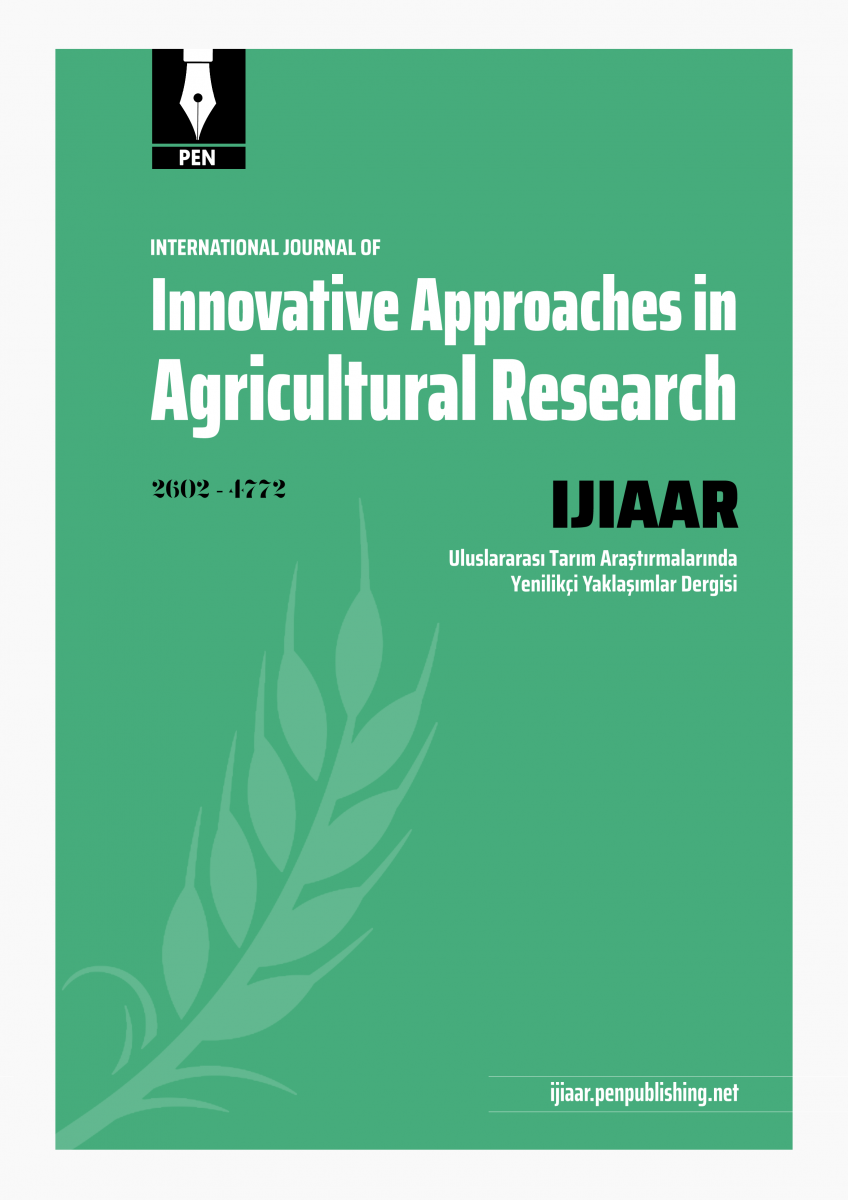Original article | Open Access
International Journal of Innovative Approaches in Agricultural Research 2019, Vol. 3(2) 287-298
Host Specificity of Sudan Witchweed (Striga Hermonthica [Del.] Benth.) Seed Germination and Haustorium Initiation in Response to Sorghum Root Exudates and Extracts
Awadallah B. Dafaallah, Abd Elgabar T. Babiker & Abbasher Awad Abbasher
pp. 287 - 298 | DOI: https://doi.org/10.29329/ijiaar.2019.194.14
Published online: June 30, 2019 | Number of Views: 102 | Number of Download: 664
Abstract
Field surveys and laboratory experiments were conducted during the season 2009/10 and 2010/11 in witchweed (Striga hermonthica [Del.] Benth.) endemic areas in Sudan to investigate the host specificity of witchweed populations collected from different locations with respect seed germination and haustorium initiation in response to sorghum root exudates and extracts. Field surveys were conducted to collect seeds from witchweed plants growing under their respective hosts; sorghum and millet. A total of fifteen witchweed populations were collected. Tow in vitro experiments were conducted at the Phytopathology Center and Biology Laboratory, Faculty of Agricultural Sciences, University of Gezira, Sudan to study the effects of root exudates and root extracts of sorghum cv. Abu-70, cv. Wad Ahmed and cv. Hakika on percentage of seed germination and haustorium initiation. Treatments (fifteen witchweed populations and three sorghum cultivars) were arranged in a factorial completely randomized design with three replicates. Data were collected and subjected to analysis of variance. Means were separated for significant using Duncan's Multiple Range Test (at p £ 0.5). The results showed that, there were significant differences in seed germination and haustorium initiation of witchweed in response to root exudates and root extracts among sorghum cultivars and among the witchweed populations. However, the highest seed germination and haustorium initiation percentages attained by each of the witchweed population were on their respective hosts. This study suggests two levels of physiological specialization in witchweed in Sudan: intercrop specialization and intra-crop specialization. Moreover, two strains of witchweed are suggested, one specific to sorghum and the other, to millet. The existence of variability and host specificity within witchweed populations are suggested to be based almost entirely on differential response of Striga isolates to root exudates and root extracts from host.
Keywords: Variability, specificity, host, witchweed, Striga, germination, haustorium, sorghum, exudates and extracts.
|
How to Cite this Article
|
|
APA 6th edition
Dafaallah, A.B., Babiker, A.E.T. & Abbasher, A.A. (2019). Host Specificity of Sudan Witchweed (Striga Hermonthica [Del.] Benth.) Seed Germination and Haustorium Initiation in Response to Sorghum Root Exudates and Extracts
. International Journal of Innovative Approaches in Agricultural Research, 3(2), 287-298. doi: 10.29329/ijiaar.2019.194.14
Harvard
Dafaallah, A., Babiker, A. and Abbasher, A. (2019). Host Specificity of Sudan Witchweed (Striga Hermonthica [Del.] Benth.) Seed Germination and Haustorium Initiation in Response to Sorghum Root Exudates and Extracts
. International Journal of Innovative Approaches in Agricultural Research, 3(2), pp. 287-298.
Chicago 16th edition
Dafaallah, Awadallah B., Abd Elgabar T. Babiker and Abbasher Awad Abbasher (2019). "Host Specificity of Sudan Witchweed (Striga Hermonthica [Del.] Benth.) Seed Germination and Haustorium Initiation in Response to Sorghum Root Exudates and Extracts
". International Journal of Innovative Approaches in Agricultural Research 3 (2):287-298. doi:10.29329/ijiaar.2019.194.14.
|
| References |
- Ali, R. (2008). Host specificity, physiological and genetic variability within S. hermonthica population collected from under sorghum, millet and maize. M Sc thesis, University of Khartoum, Sudan. [Google Scholar]
- Astatt, P. R. and I. M. Hansen (1978). Correlation between haustoria formation and parasitic development in Orthocarpus purpurascens (Scrophulariaceae), Ann. Bot.-London, 42, 1271-1276. [Google Scholar]
- Babiker, A. G. T. (2007). Striga: The Spreading Scourge in Africa. Regulation of Plant Growth & Development, 42, 74-87. [Google Scholar]
- Dafaallah, A. B. (2006). Effects of 2,4-D and Nitrogen on Striga (S.heromonthia (Del.) Benth.). Incidence, Grain Sorghum Growth and Parasitism. MSc Thesis, University of Gezira, Sudan. [Google Scholar]
- King, S. B. and N. Zummo. 1977. Physiologic specialization in Striga hermonthica in West Africa. Plant Dis. Rep., 61, 770–773. [Google Scholar]
- Lewin, C. (1932). Witchweed (Striga lutea var. bicolor (O. Kuntze) N. Rhod. Agriculture and Development. Bulletin, pp. 2-51. [Google Scholar]
- Musselman, L. J. (ed.) (1987). Taxonomy of witchweeds. Parasitic Weeds in Agriculture, 1, 317. [Google Scholar]
- Ramaiah, K. V. and C. Parker. 1982. Sorghum in the Eighties, pp.291-302. In: L. R. House, L. K. Mughogho and J. M. Peacock (Eds.). Proceedings of the International Symposium on Sorghum. ICRISAT. [Google Scholar]
- Rao, V. (1982). Genetic control of Striga asiatica in sorghum. In: Vidyabhushanam R.V. (ed.). ICRISAT-AICSIP (ICAR) pp 22. [Google Scholar]
- Wilson-Jones, K. (1955). Further experiments on witchweed control. II The existence of physiological populations of Striga hermonthica. Empire J. Exp. Agr., 23, 206-213. [Google Scholar]
|

